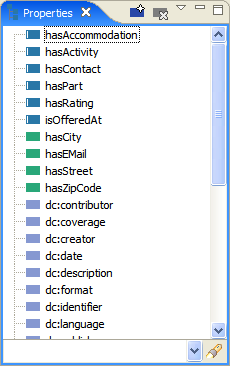
RDF and OWL properties represent relationships between two RDF nodes (resources or literals).
Supported Property Types
Using TopBraid Composer you can create:
rdf:Property class. You should use
RDF properties if you are building an RDFS ontology or if you
declare properties that may take either literals or resources
as values. For more information on how to configure Composer
to be an RDFS editor, see
Classes View Preferences
and Properties View Preferences.owl:ObjectProperty or
owl:DatatypeProperty or owl:AnnotationProperty,
or subclasses thereof such as owl:SymmetricProperty.rdf:Property, and instances of these (meta) classes are
also properties. The use of property metaclasses is rather uncommon.
Object properties link two resources within the ontology. For example, the
property livesIn might link John (an instance of
the Person class) with London (an instance of
the City class).
Datatype properties link a resource to a literal. Literals usually have an
XML Schema Datatype as their type, e.g. xsd:string or
xsd:boolean. For example, the property
telephoneNumber might link John to a string
44-10-1233400.
Using the Properties View
The Properties View shows all the properties present in the ontology or its imports. This includes properties defined in the ontology as well as built-in properties of RDFS and OWL that were configured to be visible. See Properties View Preferences on how to configure what is visible in the Properties View.

In addition to the subproperty hierarchy described above, the Properties View can also be switched to a mode in which properties will be Grouped by namespace. This mode makes it easier to see locally defined properties, but does not represent the property hierarchy at all, and thus also makes editing subproperty relationships less intuitive.
Using the Properties View, you can create new properties, define subproperties, modify and delete properties. You can also move properties between ontologies.